<i>Pterourus canadensis</i><br>
Rothschild & Jordan 1906
Pterourus canadensis
TER-our-usmm
kan-nuh-DEN-sis
Rothschild & Jordan 1906
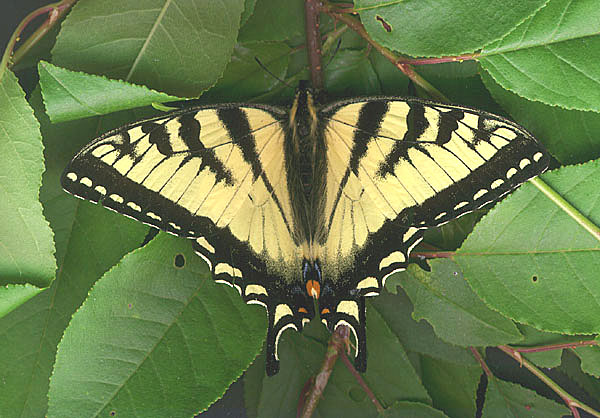
Pterourus canadensis butterfly scan by Bill Oehlke.
Superfamily: Papilionoidea
Family: Papilionidae Latreille, 1809
Subfamily: Papilioninae
Tribe: Papilionini
Genus: Papilio, Linnaeus, 1758
Subgenus: Pterourus |
Website designed and maintained by
Bill Oehlke
Box 476, 155 Peardon Road
Montague, Prince Edward Island
Canada C0A 1R0
oehlkew@islandtelecom.com
|
Distribution:
Pterourus canadensis, the Canadian
Tiger Swallowtail (wingspan: 2 5/8 - 3 1/8 inches (6.7 - 8 cm))
flies in northern deciduous and evergreen-deciduous woods and
forest edges from central Alaska southeast across Canada and the
northern Great Lakes states to northern New England.
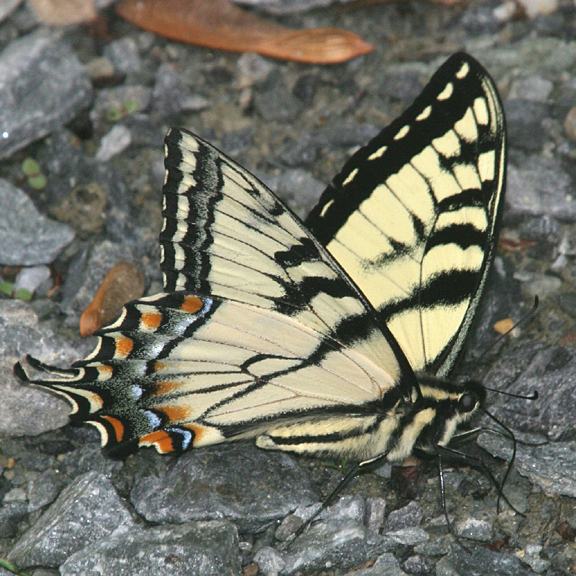
Canadian Tiger Swallowtail, Harvard, Massachusetts,
Oxbow NWR, courtesy of
Tom Murray
Description:
This species is smaller than both the
Eastern and Western Tiger Swallowtails. The forewing dorsal surface
has relatively broad black stripes. The forewing ventral surface
has marginal yellow spots, merged into continuous band.
The hindwing has numerous orange scales. There is an extremely rare
black female form.
Flight time(s) and Adult Food Sources:
Here on Prince Edward Island, the single-brooded Pterourus
canadensis butterfly is on the wing from late May until early
July.
I can always find a few Pterourus canadensis larvae as I
gather poplar foliage for Sphingidae or when I remove late
caterpillar sleeves from pin cherry or birch trees.
Generally there is a single flight from May to mid-July.
Adults nectar from a variety of flowers and are quite fond of my
blackberry blossoms. They also like to imbibe water and minerals
at mud puddles or along a streamside.
Eggs, Larvae, Pupae:
Males patrol with a fast and erratic
flight along forest edges, seeking receptive
females. Females lay eggs singly on the surface of host foliage,
including leaves of poplar, birch and
cherry. I have also found larvae on service berry
When disturbed, Canadian tiger swallowtail butterfly larvae project an orange osmetrium from
the back of the head.
The gland gives off an offensive, cheesy smelling odor, and I
discovered a larva in one of my polyphemus/birch sleeves by tracking
the smell. The larva sleeve or I must have brushed
against the caterpillar during a change.
Papilio canadensis caterpillars usually
feed at night on leaves of poplar, birch and cherry, resting by day,
mid leaf on a slightly raised
silk platform mid leaf. I have never seen one in a furled leaf.
Green camouflage colouring for last three instars, and a thorax
that looks like a snake head with menacing "false eyes"
offer protection from predation. | 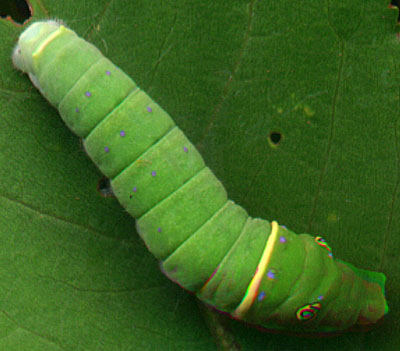
|
In the first two instars, larvae are brown/black
with a white saddle, giving them
the appearance of a bird dropping on foliage. The third instar is green with a pale saddle.Foul smelling osmetrium project from the base of the bulbous brown head (not visible here)
when the larva is disturbed. The head actually looks like a fat lip. Fourth instar scan by Bill
Oehlke.
A captured female will oviposit on cherry or poplar foliage when
placed in a Remay sleeve over hostplant.
The female should be fed at least once daily a sugar/honey/water solution to maintain vigour.
Here a fourth instar larva "looks at" you. | 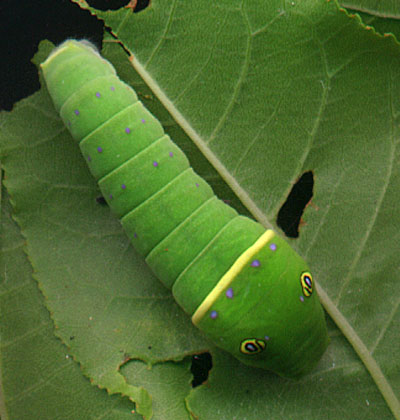 |
Larvae turn brown at pupation time and anchor abdominal tip to vertical or horizontal structures
(branches or stems) with an extensive silk pad
and then use another pad to which a thoracic "sling" is attached allowing them to hang in
typical swallowtail fashion.
| 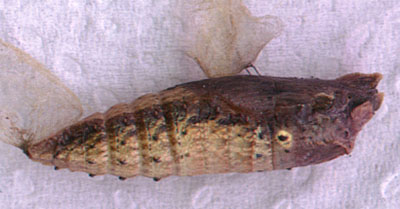 |
Silkpads and sling structures are visible in the chrysalis scan above.
Such detachment allows for easy winter storage in fridge crisper
and butterflies have no problem eclosing and inflating provided a "hanging structure" (twig or screen) is available.
Much research has been done at University of Illinois with
regard to hybridization zones of canadensis and glaucus.
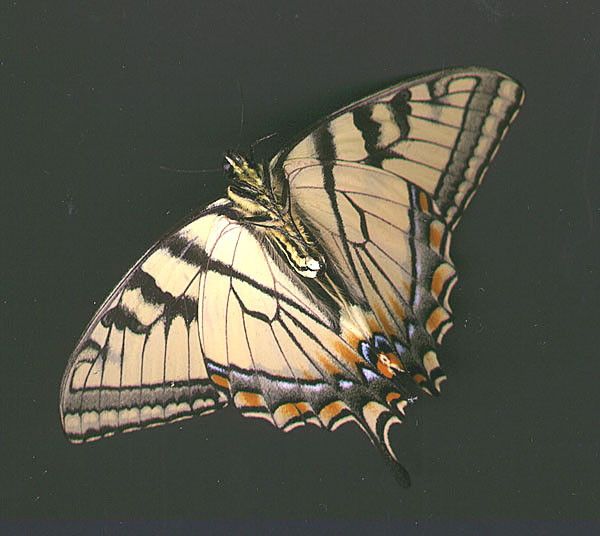
The underside offers one of the best keys to distinguishing canadensis from glaucus:
1) Canadensis has an abundance of orange scaling in the lower wing;
2) Inner yellow band on the outside edge of upper wing is continuous in canadensis, broken by black (spotted) in glaucus.
Use your browser "Back" button to return to previous page.
Visit other websites maintained by Bill Oehlke:
+++LIVESTOCK AND SUPPLIES FOR SALE***
This site is designed and
maintained
by Bill Oehlke. You can reach Bill for questions
by clicking on his name (email) or by phone 902-838-3455,
or at Bill Oehlke,
Box 476, Montague, P.E.I., Canada C0A 1R0.
I offer two membership sites that far exceed the
coverage offered
on the sites listed above:
THE WORLD'S LARGEST SATURNIIDAE SITE and
CATERPILLARS TOO!





